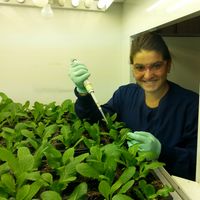The bacterium
Mycobacterium leprae is the causative agent of a disease known as leprosy. The bacterium itself is rod-shaped with parallel sides and rounded ends. The bacterium is fastidious which means it is very slow growing, a common characteristic of the
Mycobacterium genera. Because it is fastidious, the incubation period of the disease is extremely long and it can take as long as 20 years for symptoms to appear. The cells can be found in large numbers in leprosy lesions located on the skin. They are often grouped together and resemble bundles of cigars from skin cells under the microscope.
Leprosy mainly affects the skin, the peripheral nerve system and the mucosa of the upper respiratory tract and eyes. The disease is curable if treated early using multidrug therapy (MDT) however; if left untreated the disease can cause permanent damage to the skin, nerves, limbs and eyes. The World Health Organization (WHO) has estimated the number of people suffering from leprosy worldwide to be 180,618.
Leprosy has been found to be transmitted zoonotically with early surveys in the US suggesting that leprosy is mainly restricted to armadillos in Texas and Louisiana. Previous evidence of infection in armadillos in Florida, Georgia and Alabama were not reported however; a group of researchers from the US as well as Switzerland recently screened 645 armadillos in 8 different locations throughout the southeastern United States. They found
M. leprae infected animals in all 8 locations that were tested.
The serological prevalence was found to be 16.4% in all armadillos tested. They used single nucleotide polymorphism analysis (SNP) to determine the bacterial genotypes found in the animals to determine if there was any correlation between genotype and transmission to humans. They identified 35 armadillos which were infected with
M. leprae genotype 31-2-v1 as well as a new genotype (31-2-v15) in 7 other armadillos. Humans tested within the same region were found to be infected with 31 different
M. leprae genotypes. Interestingly, 42.3% of patients were infected with 1 of the 2 genotype strains that were found in armadillos.
The authors of this study concluded that there is accumulating evidence to support that leprosy is a zoonotic disease in the US which could spread to humans in all geographic regions where armadillos live. This new information suggests that new technologies to detect prevalence and spread of leprosy are needed.
Sources:
Emerging Infectious Diseases;
World Health Organization









